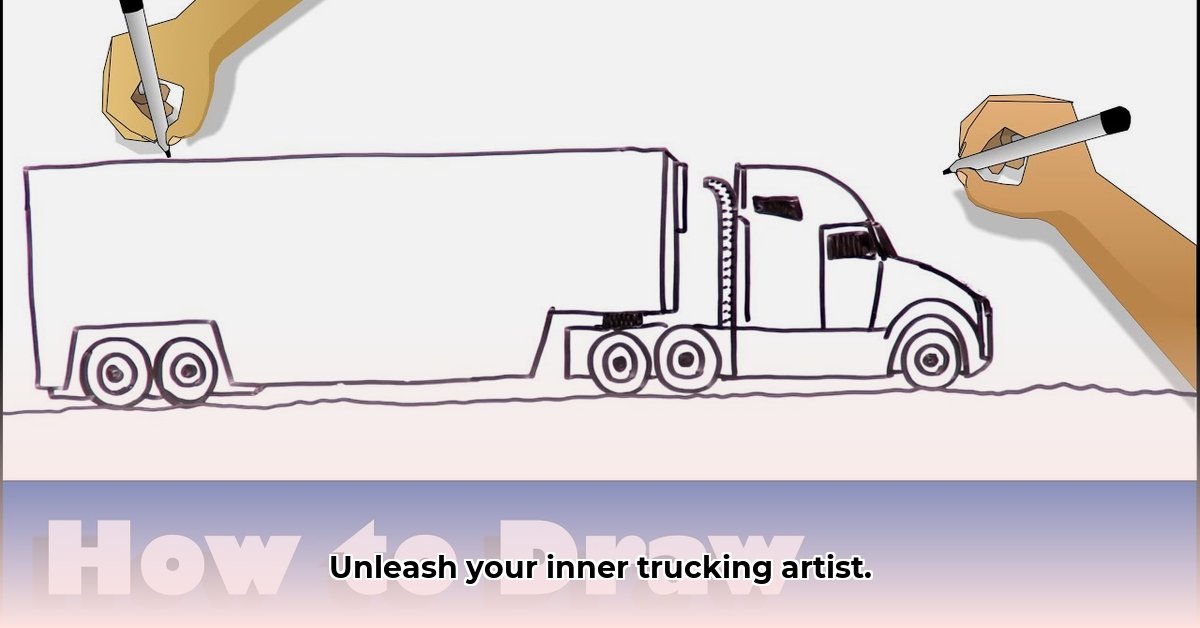
Creating compelling visuals of tractor-trailers—for marketing, technical manuals, or artistic expression—demands a nuanced understanding of illustration styles and techniques. This guide explores the diverse world of tractor-trailer illustrations, empowering you to master the art of creating impactful visuals. For more on different types of trucks, check out this helpful guide: Truck Types.
Decoding the Styles: Realism Meets Artistic License
The visual landscape of tractor-trailer illustrations is strikingly diverse. From hyperrealistic 3D renderings capturing every detail to simplified line drawings resembling architectural blueprints, and stylized vector graphics offering a clean modern aesthetic, the choice of style significantly impacts the final message. The optimal style hinges entirely on the project's goals.
Consider the analogy of photography: a photorealistic rendering is akin to a high-resolution photograph—stunning and impactful, but less flexible for edits. Simplified line art resembles a quick sketch – fast, expressive, and easily modified. Vector graphics are like building with LEGOs; easily scaled, adapted, and customized.
Here's a comparison of the styles, highlighting their pros and cons:
| Style | Advantages | Disadvantages | Ideal Applications |
|---|---|---|---|
| Photorealistic Rendering | Stunning detail, realistic feel, highly impactful | Time-consuming, complex, less adaptable for edits | High-end brochures, advertisements, concept art |
| Simplified Line Art | Quick to create, expressive, easily modified, clean and uncluttered | Less detail, potentially less visually striking | Quick sketches, technical drawings, simple branding, infographics |
| Stylized Vector Graphics | Infinitely scalable, easily edited, clean aesthetic, consistent branding | Requires specific skills, can appear generic if not creatively handled | Logos, website graphics, marketing materials, branding |
Isn't it fascinating how different approaches can achieve vastly different results? This variety allows designers to tailor their work to specific audiences and purposes.
The Vector Revolution: Why It's the Workhorse of Modern Illustration
For branding and applications demanding scalability, vector graphics are paramount. Their resolution independence means they resize without quality loss. A tiny website icon or a massive billboard image? Vector graphics handle both flawlessly. Their unparalleled editability allows for modifications without redrawing. EPS-10 files, commonly used, facilitate manipulation of individual layers (components of the image). Think of an EPS-10 file as a sophisticated digital construction set, with independent components allowing for precise control and flexibility. This adaptability is crucial for modern branding consistency.
Your Step-by-Step Guide: From Concept to Stunning Visual
Creating exceptional tractor-trailer illustrations involves careful planning and execution. This step-by-step guide offers a practical roadmap:
Define Your Objective: What's the illustration's purpose? A marketing campaign requires a different approach compared to a technical manual. This dictates the style selection.
Select Your Style: Choose the style that best serves your needs based on your objective. Consider the overall message and target audience.
Choose Your Tools: Adobe Illustrator is the industry standard for vector graphics. Photoshop excels with raster graphics like photorealistic illustrations. Other software options exist, depending on your familiarity and project needs.
Gather Inspiration: Explore online resources like design platforms or Pinterest to gather ideas. Remember, inspiration should spur creativity; avoid direct copying.
Sketch and Refine: Start with a rough sketch. This helps to solidify ideas and composition before detailed work.
Create Your Masterpiece: Use your chosen software to transform the sketch into a polished illustration. Pay close attention to detail; maintaining visual style and overall aesthetics is vital.
Assess and Export: Review the work for errors. Does the style align with objectives? Export in the correct format (e.g., EPS-10 for vectors, JPEG or PNG for raster images).
Actionable Insights for Different Stakeholders
Effective tractor-trailer illustrations benefit various groups. Here's how different stakeholders can leverage them:
Graphic Designers: Stay current with design trends. Explore generative AI tools to enhance efficiency. Mastering advanced vector editing is highly valuable.
Branding Agencies: Custom-designed, high-quality vector graphics create unique and memorable brand identities. Invest in such assets for transportation industry clients.
Transportation Companies: Use professional-quality illustrations in marketing materials, website designs, and internal documents to enhance brand image and communicate information effectively.
Educational Institutions: Integrate various illustration styles into design programs, exposing students to different techniques.
Creating impactful tractor-trailer illustrations requires both technical skill and artistic vision. By carefully considering these factors, you can craft effective visuals that resonate and leave a lasting impression.